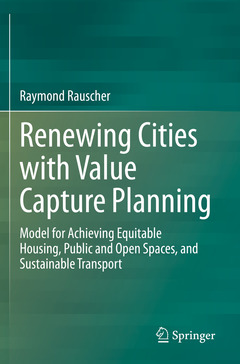Renewing Cities with Value Capture Planning, 1st ed. 2021 Model for Achieving Equitable Housing, Public and Open Spaces, and Sustainable Transport
Auteur : Rauscher Raymond

The book offers a model for city development and renewal based on land value capture (called ?value capture?). Firstly, a review is presented of cities around the world that are currently using value capture. From these city examples the author shows how any state, city or regional government can adopt value capture policies. Looking at recent events the author reviews the implications of the coronavirus pandemic (2020) for future planning (including value capture) of cities and regions (particularly noting healthy cities planning).
The development of a value capture planning (VCP) model is then outlined. The basis of the model is reflected in its planning components, being: Housing (affordable, social and market housing); Public andOpen Spaces (natural areas, open spaces and public spaces); and, Sustainable Transport (rail, bus, and active transport). The VCP model is devised to provide an economic and planning tool that can be utilised in addressing each of these planning components. This tool includes data entry tables and explanations of how these tables are applied.
Four case study cities (within Australia) currently undergoing renewal are selected for the model to be applied to. The areas were chosen to represent contrasting urban settings and types of development and renewal, including: inner city, middle ring city; growth centre city; and, regional capital city. The current (2020) active renewal programs within these areas include (city in brackets): Central to Eveleigh Renewal Area (CERA) (City of Sydney); Sydenham to Bankstown Urban Renewal Corridor (SBURC) (Canterbury Bankstown City); Gosford City Centre Revitalisation(GCCR)area (Gosford City); and, Newcastle City Renewal Area(NCRA) (Newcastle City).The reader is walked through (graphically) the backgrounds of these case study cities, including geography, development trends and details of renewal plans. Conclusions on the VCP model application are outlined for each study area (within that chapter) and for the cumulative results across all study areas (final chapter). With these conclusions, the application of the model to any city or region anywhere in the world is outlined.
Finally, on a practical level the reader would be interested in how value capture is administered through programs (including the roles of government, developers and the community). Summing up, the book offers the reader an understanding of current city planning and the tools (like value capture) that will be required for future planning.
Raymond Charles Rauscher is a conjoint lecturer at the University of Newcastle, Australia, and a director of the Habitat Association for Arts and Environment Inc. Ray was born in Brooklyn, New York City (1943), and graduated from the City College of New York (Bachelor of Engineering (Civil) (1966)). He later completed part one of a master’s degree at the University of Michigan (research on Detroit entitled ASolution to the Urban Crisis: Proposal for the Creationof Region Serving New Cities (unpublished 1969)). His Master of Town and Country Planning degree was completed at the University of Sydney (1971), including a thesis Community Response to a RedevelopmentProposal (Sydney) (University of Sydney Library Microfilm Department 1971). The thesis covered planning conflicts in Erskineville (Sydney) and a framework to resolve urban planning conflicts. Delving into the subject of sustainable urban planning (SUP), Ray completed a PhD (2009) at the University of Newcastle, Australia.
Following further research, Ray published Sustainable Communities: A Framework for Planning (Springer 2014). Moving to address urban renewal, Ray completed research and published Brooklyn’s Bushwick – Urban Renewal inNew York, USA (Springer 2014). Researching further, Ray then examined urban planning (from the 1970s) in inner city neighborhoods of Sydney, publishing Sustainable Neighborhoods in Australia: City of Sydney Urban Change (Springer 2015). Moving from the inner city planning, Ray then researched how cities were coping with today’s impacts of global changes (i.e., population and environmental impacts) and published Cities in Global Transition: Creating SustainableCommunities in Australia (Springer 2016). The instance of these global impacts on neighborhoods led Ray to commence research on the extent that cities, in planning neighborhoods, address Sustainable City Principles
Provides the reader with planning templates to be implemented in achieving more equitable city development and renewal
Enables the reader to gain an overall understanding of current city planning and the tools (like value capture) that will be required for future planning
Four in-depth case studies graphically describe the key aspects of ground city development and renewal
Date de parution : 01-2022
Ouvrage de 182 p.
15.5x23.5 cm
Disponible chez l'éditeur (délai d'approvisionnement : 15 jours).
Prix indicatif 158,24 €
Ajouter au panierDate de parution : 01-2021
Ouvrage de 182 p.
15.5x23.5 cm
Disponible chez l'éditeur (délai d'approvisionnement : 15 jours).
Prix indicatif 158,24 €
Ajouter au panier


